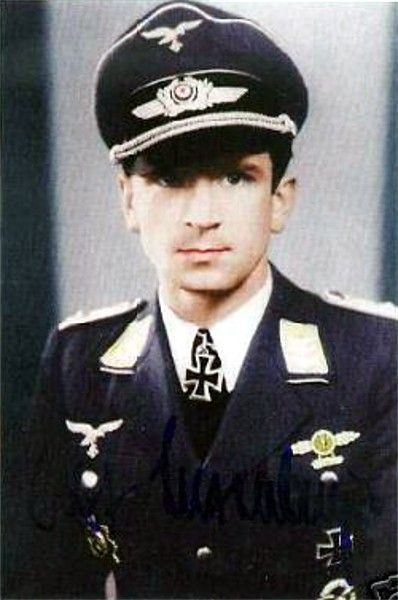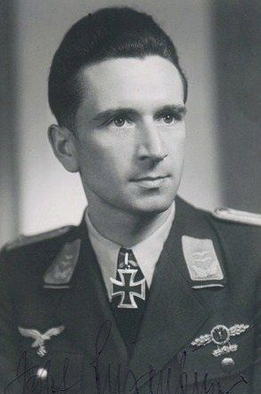Luxenburger, Josef (Kampfgeschwader 55 'Greif')
- Date of birth:
- April 2nd, 1915 (Beckingen/Rhine Province, Germany)
- Date of death:
- February 5th, 2009 (Neustadt an der Weinstraße/Rhineland-Palatinate, Germany)
- Nationality:
- German
Biography
Fall 1936: entered the Heer and received basic training with Inf.Rgt. 17
1937: transferred to the Luftwaffe
1938: in Fl.Ausb.Rgt. 12, then as a Bordfunker in 6. /KG 155, 6./ KG 55
09.1938: transferred to II./ KG 254 (later II./KG 55)
09.1939: Unteroffizier with 4./ KG 55
05.1940: with Stab II./ KG 55
03.03.1941: Feldwebel awarded the Ehrenpokal
05.1941: attained 125 missions
End 1941: underwent observer training with IV./ KG55
01.1942: transferred to LKS 1 for officer training
02.01.1942: Oberfeldwebel awarded DKiG, II./ KG 55
05.1942: returned to 4./ KG 55
Summer 1942: promoted to Leutnant
09.1942: promoted to Oberleutnant
27.12.1942: reached his 425th mission
12.1942-01.1943: flew 22 supply and evacuation missions to Stalingrad
08.03.1943: transferred to Stab/ KG 55 as Ia
03.04.1943: Oberleutnant in 4./ KG 55, awarded the Ritterkreuz on completion of 425 combat missions
01.09.1943-18.04.1944: Oberleutnant, appointed Staka 4./ KG 55
01.11.1943: promoted to Hauptmann
12.11.1943: flew his 500th mission
20.02.1944: transferred to Stab Lfl. 6
mid 1944: transferred to Stab 4. Fl.Div.
12.1944: transferred to FFS A 12 for flight training, but this was cancelled on 02.45 1945: sent to Fsch.Jg.Rgt. 1 in northern Italy
01.02.1957: joined the Bundeswehr
30.09.1973: retired as an Oberst i.G.
Credited with 505 combat missions
Flew in a total of 505 combat missions, which were counted as approximately 573 front flights.
Do you have more information about this person? Inform us!
- Period:
- Second World War (1939-1945)
- Rank:
- Oberfeldwebel (Flight Sergeant)
- Unit:
- II. Gruppe, Kampfgeschwader 55, Luftwaffe
- Awarded on:
- January 2nd, 1942
According to the Vorschlag of the Ritterkreuz awarded on 12-1-1942.
- Period:
- Second World War (1939-1945)
- Rank:
- Oberleutnant (Flying Officer)
- Unit:
- Beobachter, 4. Staffel, II. Gruppe, Kampfgeschwader 55, Luftwaffe
- Awarded on:
- April 3rd, 1943
“Oberleutnant Luxenburger was awarded the German Cross in Gold after he had demonstrated merit over the course of flying 200 missions as a Feldwebel and radio operator.
Since then he has flown a further 225 sorties as a bomber observer, and in this time he has demonstrated the highest personal bravery and readiness and achieved notable successes.
The following feats-of-arms he rendered are particularly noteworthy:
1. On the 24.06.1942 Oberleutnant Luxenburger carried out a 5000 m high attack at dusk against the NE exit of the Waluiki train station. Despite the presence of powerful AA defenses he managed to set a fuel train on fire, and the blaze proved so great that it illuminated a nearby fuel depot that had a capacity of about 1000000 litres. This was spotted and destroyed on the following night during a strike by two Gruppen.
2. On the night of the 02./03.06.1942 the Gruppe launched a highly successful attack against the train station at Rossosch. It resulted in the annihilation of the locomotive repair and maintenance workshops present as well as almost all warehouses with a great number of locomotives and trains. The Gruppe achieved a similar success when it carried out a night raid against the Kotelnikowo train station on the night of the 28.07.1942, with one outcome being the temporary blocking of the Stalingrad—Caucasus railroad. Both of these achievements are heavily attributable to the excellent bombing accuracy of Oberleutnant Luxenburger, who served as a bomber observer to the Staffelkapitän during both missions.
3. On the 07.,08.,13., and 15.07.1942 Oberleutnant Luxenburger delivered his payloads with deadly effect during Ketten/Staffel attacks against transport/ammunition trains and troop concentrations at the train stations of Bossyi and Glubokji and near Dolschariskaja and Nowo-Nikalewsky.
4. His masterful bombing accuracy made him a decisive contributor to the successful destruction of the great Don bridges at Rostov and Aksaiskaja whilst his Gruppe launched high altitude attacks on the 16., 17. and 19.07.1942. These attacks were carried out against heavy AA fire and even sporadic fighter attacks.
5. On the 11., 12., 13., 17. and 18.08.1942 he participated in attacks (carried out from a 3-5000 metre altitude) against the Caucasus ports of Gelendshik, Nowotscherkask and Temrjuk. Despite the presence of heavy AA fire he managed to sink 1 ship and heavily damage another 5.
6. On the 29., 30. and 31.10.1942 he knocked out several batteries whilst conducting high-level attacks against battery positions east of the Volga near Stalingrad. These were heavily defended by AA guns.
7. On the 08.12.1942 Oberleutnant Luxenburger conducted a bombing run against hostile tank/troop assemblies near Dmitrijewka, and all of his bombs were hits.
Oberleutnant Luxenburger has flown 89 sorties at Stalingrad, including 22 supply missions that involved landing at the Pitomnik airfield amidst weather conditions that were sometimes extremely unfavourable.
His grand total of 425 sorties puts him among the most experienced of all personnel in the Geschwader.
He is a marvellous example for all crews of his Gruppe thanks to the unbreakable positive spirit that he exudes on every combat mission flown.
Oberleutnant Luxenburger was still a radio operator in 1941, however thanks to his energy and rock-solid offensive spirit he has become one of the best bomb aimers in the Gruppe after having received a short period of instruction as a bomber observer. I believe him to be highly worthy of receiving the Knight’s Cross to the Iron Cross in recognition of his proven will-to-fight and his actual combat achievements.”
Of Luxenburger’s total of 425 sorties flown, 12 were flown against Poland, 22 against France, 90 against Britain, 77 against the Soviet Union in 1941 and 224 against the Soviet Union in 1942.
- Period:
- Second World War (1939-1945)
- Awarded on:
- September 14th, 1940
- Period:
- Second World War (1939-1945)
- Awarded on:
- November 25th, 1939
- Period:
- Second World War (1939-1945)
- Period:
- Second World War (1939-1945)
- Awarded on:
- January 1st, 1943
- Period:
- Second World War (1939-1945)
- Period:
- Second World War (1939-1945)
- Rank:
- Feldwebel (Sergeant)
- Unit:
- II./ KG 55
- Awarded on:
- March 3rd, 1941
According to the Vorschlag of the Ritterkreuz awarded on 22-3-1941.
Sources
- Photo 1: Willi Schumacher
- Photo: Willi Schumacher collection
- - FELLGIEBEL, W.P., Elite of theThird Reich, Helion & Company Limited, Solihull, 2003.
- PATZWALL, K. & SCHERZER, V., Das Deutsche Kreuz 1941-1945, Band II, Verlag Klaus D. Patzwall, Norderstedt, 2001.
- URBANKE, AXEL & KAISER, JOCHEN, Die Ritterkreuzträger der Kampfflieger, Luftfahrtverlag-Start, 2011.
- Ritterkreuz Archiv II/2009, Veit Scherzer, Ranis, Juni 2009, ISSN 1866-4709
- BArch RH 7/296











